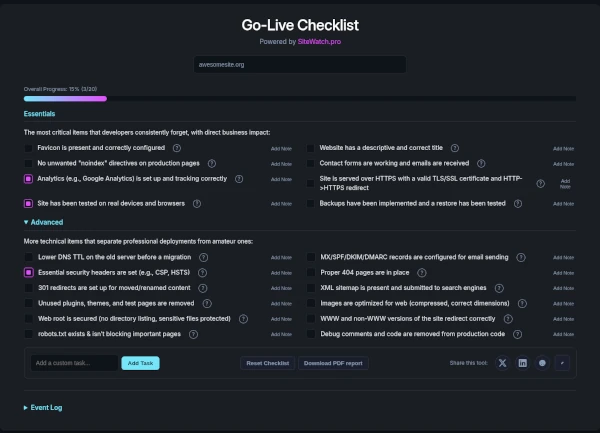The Ultimate Website Go-Live Checklist: Launch with Confidence
Authored by SiteWatch.pro Team, Last updated: 2025-08-31
🚀 The Ultimate Website Go-Live Checklist
Launching a website is exciting - but missing critical steps can lead to embarrassing, costly, or dangerous problems down the road.
That’s why we’ve crowdsourced the Go-Live Checklist from real developers on r/webdev and distilled it into a practical, actionable guide.
By following this checklist, and understanding why each directive matters, you’ll launch confidently, avoiding last-minute disasters and maximizing your website’s impact.

Essentials Before Launch
These foundational items are the highest-impact. Skip them and you risk SEO, security, user trust, and business continuity.
1. Favicon present and correctly configured
Browsers and search engines cache favicons for months. Without one, your site looks unfinished in search results and tabs. Changing it later is tough!
2. Page title and meta tags set
Don’t launch with "React App" or "Vite" as your title!
Set descriptive titles and appropriate meta description tags for every page. These affect search results display and help users instantly understand your content.
3. Remove unwanted noindex directives
Leaving noindex on production blocks your site from Google and Bing. Before launching, audit every page to ensure it’s indexable.
4. Analytics and tracking scripts configured
Migrating or launching a site? Double-check that Google Analytics, Facebook Pixel, or other scripts are working. Missed tracking equals missed insights.
5. HTTPS enforced and TLS/SSL certificate valid
All traffic must redirect from HTTP to HTTPS.
A valid certificate avoids user trust issues and prevents “Not Secure” browser warnings.
6. Test on real devices and browsers
Don’t rely solely on dev tools. Use actual phones and tablets, including older devices and browsers, to catch layout or functional problems.
7. Contact forms working, emails received
Test every form submission with multiple email providers. Check for spam filtering issues and confirm leads reach their destination.
8. Backups exist and restores have been tested
Before launch, verify that backups run and that a successful restore is possible. Data loss during migration can be fatal for businesses.
Advanced Enhancements
Finish these to launch like a pro. They’ll protect your brand, performance, and security long-term.
Lower DNS TTL before migrations
Shorten the DNS Time-To-Live at least 24h before servers change, so users see your new site faster, not the old one.
MX records transferred (email continuity)
If you migrate DNS, double-check MX records for email. Overlook this, and you’ll have silent email outages.
Strong security headers
Enforce HTTP headers:
Strict-Transport-Security, X-Frame-Options, Content-Security-Policy, X-Content-Type-Options.
Why: Mitigates clickjacking, XSS, and information leakage. Test on securityheaders.com for best practices.
Custom 404 page returns proper HTTP status
Always deliver an actual 404 - not just a redirect to home. For SEO and user clarity, customize it to help users recover gracefully.
301 redirects and legacy URL management
Map old or changed URLs to new destinations. Keeps SEO rankings and prevents broken links.
XML Sitemap and robots.txt
Submit sitemaps to Google and Bing. Configure robots.txt to cleanly allow/deny crawler paths.
Remove unused plugins/themes (WordPress)
Extra plugins are extra attack surface. Purge what’s not needed. Less is safer.
Optimize and compress images
Large, uncompressed images kill performance. Use optimized formats (WebP, PNG, JPEG) and keep hero images under 250KB.
www and non-www domains configured
Decide if your main website should be served from www.<mydomain>.com or <mydomain>.com directly. Set up proper redirects, and avoid serving the same content over both URLs.
Debug comments and code are removed
Leaving debug comments in production code looks not only unprofessional, but can expose sensitive information.
Regular Maintenance (After Launch)
Go-Live is only Day One - keep going!
- TLS/SSL monitoring: Track expiration, renew early
- Broken link detection: Internal and external, for SEO and UX
- Performance audits: Monitor with Lighthouse/web vitals, watch for drift
- Error log reviews: Server and app logs: silent errors are silent failures
- Backup verification: Schedule restore tests, not just backup jobs
- Security updates: Keep software, plugins, dependencies patched
Conclusion
Launching a site is a milestone. Doing it right means checking every box, not just getting it live.
SiteWatch.pro helps automate the essentials, so you focus on growth instead of firefighting.
Want this checklist as a PDF, or a live interactive version? Try SiteWatch.pro’s Go-Live Checklist today. It’s completely free, no account required.
